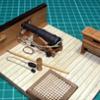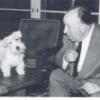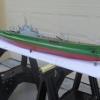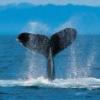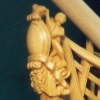MORE HANDBOOKS ARE ON THEIR WAY! We will let you know when they get here.
×
-
Posts
5,910 -
Joined
-
Last visited
Reputation Activity
-
 BANYAN reacted to Vegaskip in Ship paintings
BANYAN reacted to Vegaskip in Ship paintings
Another of my all time favourites
Armed Merchant Cruiser Carinthia on the Northern Patrol 1940 she was Torpedoed west of Galway Bay by U 46 at 13:13 on the sixth of June 1940. Four crew members were killed.
W/C 12 X 9 inches.
Jim
-
 BANYAN reacted to EdT in Young America 1853 by EdT - FINISHED - extreme clipper
BANYAN reacted to EdT in Young America 1853 by EdT - FINISHED - extreme clipper
Young America - extreme clipper 1853
Part 250 – Fore Yard Truss
Lower yards on ships of this type were attached to the masts using iron trusses. The fore yard truss will position the yard about 6 feet forward of the mast. It is configured in the form of a universal joint that allowed the yard to be "braced", that is, rotated around the mast, or "topped," raised at one end or the other. The weight of the yard was taken mostly by a separate chain sling shackled to the center of the yard and bolted to the mast just below the hounds. Making and fitting of both these parts are described below.
A pattern for the yoke that connects the truss to the yard is pasted to a 1/8" copper plate in the first picture.
This curved yoke lies in the horizontal plane, has vertical holes at the ends for bolting to yard band brackets and horizontal hole through its center for a bolt to a universal fitting that will allow vertical rotation and topping. The shape of the yoke was first cut out using a jeweler's saw, then filed to a rounded shape. The next picture shows the shaping in progress and the yard band bolt holes drilled.
The wide band at the center of the yard will be drilled for the sling eyebolt. The next picture shows the universal fitting bolted through the yoke. It has an eye at the aft end to fit the bracket in the mast band that was installed earlier.
In the picture, two long wire bolts have been inserted through the yard band brackets and yoke eyes. These were first peened to form rivet heads as shown in the next picture.
The pliers in the picture have half-round slots filed into the jaws that allow wire to be held for peening of the end. I believe this process was described earlier, perhaps in a Naiad post. In the next picture one of the long bolts has been clipped off on the underside, leaving just enough for its head to be peened, locking the yoke arm to the bracket.
A flat-end center punch was used for this. The other bolt was then inserted, clipped and peened to complete the attachment. Unfortunately I did not take photos when making the universal fitting, so a description of that will await work on a later mast. Note in the picture that the yard bands are pinned to the underside of the yard with small copper bolts.
The weight of the yard, as mentioned above was mostly taken by a chain sling. This is shown in the next picture, shackled at one end to an eyebolt temporarily inserted through the central yard band.
To set the length of the chain, the yard was temporarily hung and the chain held with tweezers as shown in the next picture.
The tweezers were used to hold the chain at a link that could be fitted with an eyebolt into the mast that would hold the truss level. The chain was cut at this point and an eyebolt spun onto it. The hole for the eyebolt was then spotted on the mast, again by holding the eyebolt with tweezers and marking the height that would hold the truss level. The next picture shows the yard hung temporarily with eyebolts inserted.
The next picture shows the yard fully braced around to the point where it contacts the forestay and almost touches the forward lower shroud.
There is still much work to do on this yard before installing it permanently, some of the parts were shown earlier. Others will be described in the next parts.
Ed
-
 BANYAN reacted to lmagna in Looking for galley stack /chimney /funnel / ventilator / flue fitting
BANYAN reacted to lmagna in Looking for galley stack /chimney /funnel / ventilator / flue fitting
Hi Charlie
You might try using a straight tube of K&S brass, (Or solid rod if you prefer). Cut a piece somewhat longer than you will need and chuck it into a Dremel, drill, or what ever you use and file the taper on the end. K&S tubing has fairly thick walls. When you get the taper you want cut a notch at the bending location and fold it 45 degrees. you can then either solder or if you prefer glue it and like stated before build the base from anything you want. One way would be to take the next size larger tubing and make another tapered cone just like the first and when you have the right shape cut it off and slide it over the other main pipe. Again solder or glue.
You can do pretty much the same thing using aluminum tubing but I find the softer metal, not being able to solder it, plus it likes to clog my files more trouble than using brass.
Give it a try, if nothing else it is a cheap experment.
Lou
-
 BANYAN reacted to CharlieZardoz in Looking for galley stack /chimney /funnel / ventilator / flue fitting
BANYAN reacted to CharlieZardoz in Looking for galley stack /chimney /funnel / ventilator / flue fitting
Ooof yeah that might be an alternative however my skill in metal work is ziltch. Especially for something so small however if no suitable brass parts are out there (figured someone might know on here) well I might very well give it a go from scratch. Its the fact that it tapers toward the end that feels challenging.
-
 BANYAN got a reaction from CaptainSteve in Looking for galley stack /chimney /funnel / ventilator / flue fitting
BANYAN got a reaction from CaptainSteve in Looking for galley stack /chimney /funnel / ventilator / flue fitting
I have not seen one of that shape during my searches Charlie; I wish you luck.
Have you considered making one? Seems like a bit of suitably sized brass tube cut cleanly at 45 degrees then soldered to form the 90-degree angle would make the main part. Simply find some conical shape in any material/medium, drill out and slide over the base - paint it black and hey presto
cheers
Pat
-

-
 BANYAN got a reaction from Jack12477 in Cutter Cheerful 1806 by Rustyj - FINISHED - 1:48 Scale
BANYAN got a reaction from Jack12477 in Cutter Cheerful 1806 by Rustyj - FINISHED - 1:48 Scale
Nice work Rusty; the detail on that lower sling is stunning.
cheers
Pat
-
 BANYAN got a reaction from mtaylor in SS Michelangelo 1962 by shipmodel - FINISHED - 1/350 scale
BANYAN got a reaction from mtaylor in SS Michelangelo 1962 by shipmodel - FINISHED - 1/350 scale
Nice work on the forecastle fittings Dan, she is really taking on her finery now!
cheers
Pat
-
 BANYAN got a reaction from Martin W in HMS Pegasus 1776 by Trussben - 1:48 - Swan-class sloop based on TFFM
BANYAN got a reaction from Martin W in HMS Pegasus 1776 by Trussben - 1:48 - Swan-class sloop based on TFFM
The contrast really makes the wales pop Ben; nice work.
cheers
Pat
-
 BANYAN got a reaction from mtaylor in HMS Pegasus 1776 by Trussben - 1:48 - Swan-class sloop based on TFFM
BANYAN got a reaction from mtaylor in HMS Pegasus 1776 by Trussben - 1:48 - Swan-class sloop based on TFFM
The contrast really makes the wales pop Ben; nice work.
cheers
Pat
-
 BANYAN got a reaction from Canute in SS Michelangelo 1962 by shipmodel - FINISHED - 1/350 scale
BANYAN got a reaction from Canute in SS Michelangelo 1962 by shipmodel - FINISHED - 1/350 scale
Nice work on the forecastle fittings Dan, she is really taking on her finery now!
cheers
Pat
-
 BANYAN reacted to Vegaskip in Ship paintings
BANYAN reacted to Vegaskip in Ship paintings
Here is a potted history of the Royal Navy Submarine Branch
1 WW1 up to WW2
2. WW2
3. Post WW2
4. 1950's to present day.
jim
-
 BANYAN reacted to Rustyj in Cutter Cheerful 1806 by Rustyj - FINISHED - 1:48 Scale
BANYAN reacted to Rustyj in Cutter Cheerful 1806 by Rustyj - FINISHED - 1:48 Scale
I've completed the Foresail Halliard, Jib Halliard and the inhaul and outhaul.
Hard to see in these pics but they are there.
Sorry Bob but you're really gonna have to strain to proof these.
Here is the lower yard sling and the sling in place on the yard.
As I made both yards earlier I'm hoping to make a good deal of progress in the next couple of days.
-
 BANYAN reacted to Dan Vadas in Bismarck by Dan Vadas - FINISHED - GPM - 1:200 - CARD and PE
BANYAN reacted to Dan Vadas in Bismarck by Dan Vadas - FINISHED - GPM - 1:200 - CARD and PE
I've built the Forward 3rd Deck. This went together well, though there is a slight mistake in one small area - it's going to be difficult to spot later on when other items are fitted, so I'll leave it :
I've glued the 3rd deck to the 2nd deck. The mistake referred to earlier can be seen below, where the two decks don't align properly in the black area. A bit of paint will fix it :
The balustrade at the forward end of the deck was difficult (I had to re-do it twice), mainly due to no instructions on how it went together. This is a recurring theme of this kit :
Danny
-
 BANYAN got a reaction from Piet in Young America 1853 by EdT - FINISHED - extreme clipper
BANYAN got a reaction from Piet in Young America 1853 by EdT - FINISHED - extreme clipper
The detail you achieve is astounding Ed; I can't wait for you to get this Volume published. Vol 2 is on its way soon (Xmas pressie :)) which will help me tremendously with some of the upper deck furniture/fittings I need to make.
cheers
Pat
-
 BANYAN got a reaction from Piet in Young America 1853 by EdT - FINISHED - extreme clipper
BANYAN got a reaction from Piet in Young America 1853 by EdT - FINISHED - extreme clipper
Very nice work which is up to your usual very high standard Ed; those yards are very clean and the copper banding adds great detail.
cheers
Pat
-
 BANYAN got a reaction from Piet in USS Constitution by SawdustDave - FINISHED - 1:60th Scale
BANYAN got a reaction from Piet in USS Constitution by SawdustDave - FINISHED - 1:60th Scale
Excellent work Dave; patience is paying off - that is one nice looking wheel.
cheers
Pat
-
 BANYAN got a reaction from Dave B in sequence for attaching deadeyes
BANYAN got a reaction from Dave B in sequence for attaching deadeyes
Hi Snow,
My preference is to attach the bottom deadeyes (closest to channels) as part of fitting the chain plates. Basically, I attach the deadeye off the ship as part of the total chainplate fixture. I then attach the bottom end of the chainplates and position each of these in the associated notch in the channels. Once positioned, I add the edge strip to the channels in a temporary way (no glue) locking the lower deadeyes in place while you get the rigging of the upper deadeyes sorted. Do not glue the outer edge strip in place until you are confident there will be no need to replace/refit a chain plate etc. (I learned the hard way as I snapped several chainplates at weak solder points when doing ratlin and other rigging tasks that put stress on them.).
I fit the upper deadeyes to each shroud leg on the ship having made a jig (a search of this site will show a few different types of jigs) to ensure they will all be level. Once the upper deadeyes have been secured to the shrouds, I then lash each set in turn with their lanyards, ensuring even tension on each. It is best to loosely reeve each lanyard, then tighten each incrementally until you have sufficient tension on the shrouds and ensuring each of the deadeyes in the upper rows remain level.
I only temporarily tie off the tails of the lanyards until well into the rigging. Once all are done and the ratlines etc completed I finally tie them off permanently so that should the inevitable 'accident' occur, you do not have to destroy the lanyard or the shroud in getting it off.
I hope that helps you.
cheers
Pat
-
 BANYAN reacted to JerseyCity Frankie in Scottish Maid rigging pt2 - spanker sheets.
BANYAN reacted to JerseyCity Frankie in Scottish Maid rigging pt2 - spanker sheets.
I was just flipping though an issue of Model ShipwrightMagazine, #94, and there is an artical about Scottish Maid with photos.
-
 BANYAN reacted to cog in Hr. Ms. O16 by cog - FINISHED - Pacific CrossRoads - 1:350 - Resin & PE
BANYAN reacted to cog in Hr. Ms. O16 by cog - FINISHED - Pacific CrossRoads - 1:350 - Resin & PE
It's certainly worth a try, but not with a € 83 model, something cheaper to start with ...
-
 BANYAN reacted to Vegaskip in Ship paintings
BANYAN reacted to Vegaskip in Ship paintings
Minesweepers in the Firth of Forth with North Berwick the Bass Rock and Berwick Law in the background
The picture now hangs in a house within sight of the location.
Jim
-
 BANYAN got a reaction from EdT in Young America 1853 by EdT - FINISHED - extreme clipper
BANYAN got a reaction from EdT in Young America 1853 by EdT - FINISHED - extreme clipper
The detail you achieve is astounding Ed; I can't wait for you to get this Volume published. Vol 2 is on its way soon (Xmas pressie :)) which will help me tremendously with some of the upper deck furniture/fittings I need to make.
cheers
Pat
-
 BANYAN got a reaction from mtaylor in Bismarck by Dan Vadas - FINISHED - GPM - 1:200 - CARD and PE
BANYAN got a reaction from mtaylor in Bismarck by Dan Vadas - FINISHED - GPM - 1:200 - CARD and PE
Nice work Danny, that PE looks really good!
cheers
Pat
-
 BANYAN got a reaction from mtaylor in Young America 1853 by EdT - FINISHED - extreme clipper
BANYAN got a reaction from mtaylor in Young America 1853 by EdT - FINISHED - extreme clipper
The detail you achieve is astounding Ed; I can't wait for you to get this Volume published. Vol 2 is on its way soon (Xmas pressie :)) which will help me tremendously with some of the upper deck furniture/fittings I need to make.
cheers
Pat
-
 BANYAN reacted to EdT in Young America 1853 by EdT - FINISHED - extreme clipper
BANYAN reacted to EdT in Young America 1853 by EdT - FINISHED - extreme clipper
Young America - extreme clipper 1853
Part 249 – Lower Fore Yard 3
There is a variety of ironwork to be installed on every square yard. Beginning with the iron sling band at the center and the reinforcing bands on made yards. These and other bands, as well as some structures attached to bands, like studdingsail boom brackets, must be sized to each individual yard. Others, like iron sheet blocks that hang from the center of the yard, cheek blocks for sheets at the yardarms and to some extent iron trusses, are more standardized and lend themselves to a "mass production" approach, if making seven or eight identical parts can be considered "mass." So, while the work shown in this part and the next was able to proceed, progress was soon hindered until a batch of standard parts could be produced for all the yards. Developing processes for those has taken some time and this has slowed work on the first yards. This and the next part describe work on the fore yard before interruption to make sheet and cheek blocks, to be described later.
The first picture shows iron (i.e. copper) banding at the center of the yard.
Most of this is ½" thick x 4" wide – actually slightly thicker (.010"). The center sling band is thicker (.015") – and wider. It will eventually be drilled top and bottom to secure eyebolts for the chain sling and the sheet block. Outside of that are two more thicker bands that will secure the iron yard truss, then the first reinforcing band, a band to secure a block, then a band than will attach a sheet fairlead, then two more bands, one reinforcing and one for a block. Additional bands were added out to the first studdingsail bracket that is described below.
But first, the basic banding method. This was described in an earlier post. The first step is cutting banding material to a length that will form a ring slightly smaller than the yard diameter at its location. Some ways to do this were described earlier. The ends of the band are then butted together and silver soldered. A soldering setup to keep the ends together is shown in the next picture.
Two steel blocks were used for this. After soldering, the misshapen bands are then pushed on to a wooden mandrel to shape them and provide a holder for filing (if needed), smoothing, and polishing as shown in the next picture.
Using a separate mandrel for this helps keep the spar clean. This one is maple, one of a pair in different sizes to be used for this purpose. The mandrel may also be used for sizing bands. This was described in Part 184. After this step the band is fitted to the yard, with the last ¼" or so a forced fit.
The next picture shows fabrication of a studdingsail boom bracket.
The band is made a fitted to the spar first. The square piece of hard brass is the silver-soldered to it as shown in the picture. The two brass bands under the brass leg are used to center the leg on the band width. The leg is then cut to length and the outer bands for the booms soldered on.
These are test fitted to the studdingsail booms as shown in the next picture.
The outer boom irons are made in a similar way, with the addition of a simulated roller on the bottom side of the boom band. The next picture shows the setup for soldering the roller to the bands.
The rounded out area on the copper wire will be placed under the band in the final setup before soldering, after clipping off the wire. This is a simplified simulation of the actual roller, which would be on an axle within the band diameter. In the last picture, the outer arm has been bent and inserted into the end of the yard and shown with the yard temporarily mounted.
There is more work to do on these parts, including blackening. Also, the reinforcement of the yardarm is not shown. This includes a u-shaped band wrapped around on the axis of the yard and two circular reinforcing bands over it. I will show pictures of this later. Also, this photo shows the yard truss that will be described in the next part.
Ed


